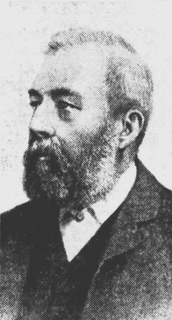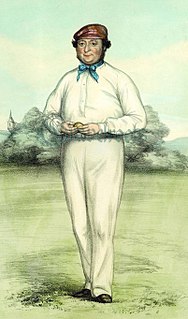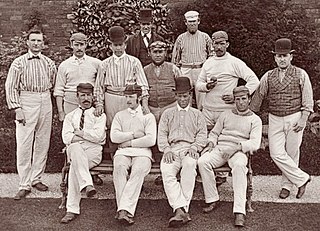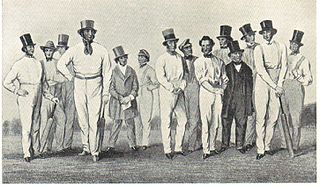Related Research Articles
1852 in sports describes the year's events in world sport.

In 1868, a cricket team composed of Aboriginal Australians toured England between May and October of that year, thus becoming the first organised group of Australian sportspeople to travel overseas. It would be another ten years before an Australian cricket team classed as representative would leave the country.

William Caffyn, known as Billy Caffyn, was an English cricketer who played mainly for Surrey County Cricket Club and various England representative sides. He played in 200 first-class cricket matches, 89 of them for Surrey. He made five appearances for New South Wales, two for Kent and one for Lancashire as well as appearing five times for the Marylebone Cricket Club.

William Clarke was an English cricketer and team manager who played first-class cricket from 1826 to 1855. He founded, managed and captained the All-England Eleven. He has been described as "one of certain figures who, in the history of cricket, stand like milestones along the way". Clarke was born at Nottingham and died at Wandsworth in Surrey.
In English cricket, the first ten years of this period were dominated by the roundarm bowling issue which was resolved when the style was legalised in 1835. The years from then to the legalisation of overarm bowling in 1864 are widely known as the "roundarm era". The first of the modern county clubs were founded between 1839 and 1845.
In English cricket since the first half of the 18th century, various ad hoc teams have been formed for short-term purposes which have been called England to play against, say, Marylebone Cricket Club (MCC) or an individual county team. The key factor is that they were non-international and there is a significant difference between them and the official England cricket team which takes part in international fixtures. Conceptually, there is evidence of this sort of team being formed, or at least mooted, since the 1730s. They have always been "occasional elevens" but, nevertheless, have invariably been strong sides. A typical example would be a selection consisting of leading players drawn from several county teams.

Charles Lawrence was an English cricketer, who played for Scotland, Ireland and England he settled in Australia after touring with the England side in 1861–62. He played for Surrey, England, Captain coach New South Wales, but is most notable as the captain-coach of the Aboriginal cricket team that toured England in 1868, the first ever tour of England by an Australian team.

John Lillywhite was an English cricketer and umpire during the game's roundarm era.

Heathfield Harman "HH" Stephenson was a famous English cricketer during the game's roundarm era.

The English cricket team in North America in 1859 was the first ever overseas cricket tour by an English team. The touring team is sometimes referred to as George Parr's XI.
The history of United States cricket begins in the 18th century. Among early Americans, cricket was as popular a bat and ball game as baseball. Though Americans never played cricket in great numbers, the game grew for some time. Around the time of the United States Civil War, the game began competing with baseball for participants, but then slowly declined in popularity. This was followed again by a brief golden age with the Philadelphian cricket team. This lasted until roughly the start of World War I; at this time, cricket again became less popular. In the latter part of the 20th century immigrants from cricket-playing nations in South Asia and the West Indies helped spark a resurgence in the game's popularity. This led to participation and success in several International Cricket Council events. In 2007, the United States of America Cricket Association was suspended by the ICC because of problems with its administration, but was again recognized beginning in 2008.

James "Jemmy" Dean was an English first-class cricketer with professional status. Mainly associated with Sussex, he is recorded in 305 matches from 1835 to 1861 which are designated first-class by CricketArchive, totalling 5,115 runs at an average of 10.54 with a highest score of 99, holding 206 catches and taking 1,144 wickets with a best analysis of 9/34. Dean achieved 5 wickets in an innings 86 times and 10 wickets in a match 18 times. His nephews David and James, both played first-class cricket.

Joseph Rowbotham was an English first-class cricketer, who played for Sheffield Cricket Club 1854–62; and for Yorkshire County Cricket Club 1863–76. In addition, he represented Marylebone Cricket Club (MCC) in 1856; the North 1857–75; the All-England Eleven (AEE) 1862–68; the Players 1864–69; an England XI in 1864; the combined Cambridgeshire and Yorkshire team in 1864; the combined Nottinghamshire and Yorkshire team in 1872; the United North of England Eleven (UNEE) 1870–75; and the Players of the North 1874–76). He played in minor and odds matches in 1865 on tour with the AEE.
Thomas Sewell Jr was an English professional cricketer whose known top-class career spanned the years 1851 to 1868. His father was Tom Sewell Sr.
The United South of England Eleven (USEE) was an itinerant cricket team founded in November 1864 by Edgar Willsher, as secretary, and John Lillywhite, as treasurer. The USEE had no home venue as its prime purpose, like all similarly named teams of the time, was to operate as a travelling show and bring top-class cricket to places in Great Britain and Ireland which rarely received it. Fourteen USEE matches have been recognised by CricketArchive as first-class, mostly against the rival United North of England Eleven (UNEE). The USEE is estimated to have played 217 "odds" matches as a visiting team against local club sides which generally used 22 players.
An England cricket team toured Australia and New Zealand in the 1863–64 season. This was the second tour of Australia by an English team, the first having been in 1861–62, and the first to visit New Zealand. Like the 1859 team in North America, this team is sometimes referred to as George Parr's XI.

The All-England Eleven (AEE) was an itinerant all-professional first-class cricket team created in 1846 by Nottinghamshire cricketer William Clarke. Widely known by its acronym AEE, it took advantage of opportunities offered by the newly developed railways to play against local teams throughout Great Britain and made its profit by receiving payments from the home clubs. In 1852, some players broke away from the AEE to form the United All-England Eleven (UEE). Similar enterprises were launched in the following years including the United North of England Eleven (UNEE) and Edgar Willsher's United South of England Eleven (USEE) which became strongly associated with WG Grace.
Hyde Park was a cricket ground in Sheffield on a site now used for high-rise community flats. It took the name of fields that occupied the area in the early 19th century. Hyde Park was used for important matches between 1830 and 1854. It opened in 1826 and was adopted by Sheffield Cricket Club as a home venue, replacing Darnall New Ground, from 1830 until 1854. It was itself superseded in April 1855 by Bramall Lane. Hyde Park staged the first "Roses Match" between Yorkshire and Lancashire in July 1849.
Frederick Reginald Reynolds was an English first-class cricketer who played for Cambridge Town Club and other Cambridge-based sides from 1854 to 1867, and for Lancashire County Cricket Club from 1865 to 1874.
In English cricket, the years 1846–1863 were the main period of the sport's "roundarm era". Although roundarm had been legalised amid great controversy, its timespan was relatively short. By 1863, there was an increasing demand for the legalisation of overarm bowling and this was achieved on 10 June 1864.
References
- 1 2 Tony Collins, Encyclopedia of Traditional British Rural Sports, Routledge, 2005, ISBN 0-415-35224-X.
- ↑ Alan Gibson, The Cricket Captains of England, The Pavilion Library, 1989. ISBN 1-85145-390-3, pp3-4.
- ↑ "The International Cricket Match", New York Times, 3 October 1859.